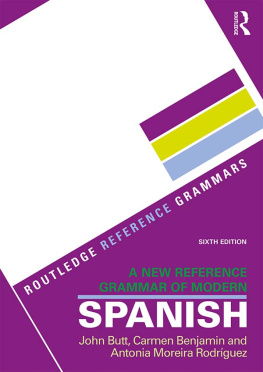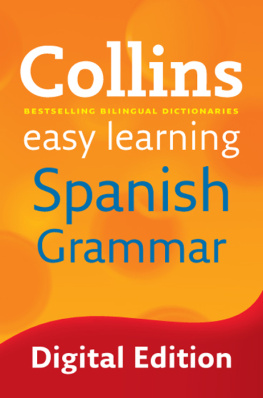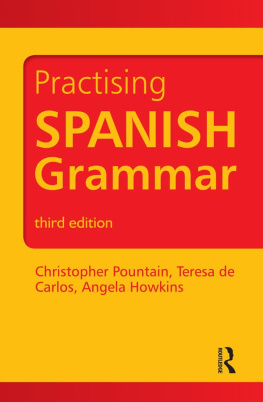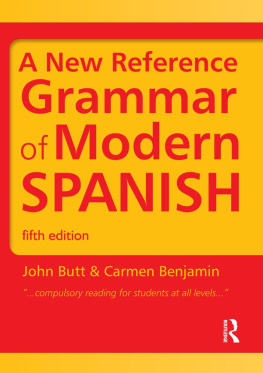A New Reference
Grammar
of Modern
SPANISH
fifth edition
John Butt & Carmen Benjamin

First published in Great Britain in 1988
Second edition published in 1994
Third edition published in 2000
Fourth edition published in 2004
Fifth edition published in 2011 by Hodder Education
Published 2013 by Routledge
2 Park Square, Milton Park, Abingdon, Oxon OX14 4RN
711 Third Avenue, New York, NY, 10017, USA
Routledge is an imprint of the Taylor & Francis Group, an informa business
Copyright 1988, 1994, 2000, 2004 and 2011 John Butt and Carmen Benjamin
All rights reserved. No part of this book may be reprinted or reproduced or utilised in any form or by any electronic, mechanical, or other means, now known or hereafter invented, including photocopying and recording, or in any information storage or retrieval system, without permission in writing from the publishers.
The advice and information in this book are believed to be true and accurate at the date of going to press, but neither the authors nor the publisher can accept any legal responsibility or liability for any errors or omissions.
British Library Cataloguing in Publication Data
A catalogue record for this title is available from the British Library
ISBN 13: 978 1 444 13769 9 (pbk)
Typeset by Servis Filmsetting Ltd, Stockport, Cheshire
Contents
This new edition of Butt and Benjamin draws extensively on the Royal Spanish Academy's Nueva gramtica de la lengua espaola of 2009, hereinafter called the NGLE. This magnificent 3885-page work is the most comprehensive grammar ever published of Spanish and, quite probably, of any language. Based on the labours of experts from twenty-two national Academies of Spanish (including the USA's), it goes further than any other work in collecting and evaluating many of the innumerable national and regional differences in syntax, morphology and meanings that characterize this language of more than 400 million speakers spread over a vast area and twenty-one countries. The Academy has now left far behind its traditional bias in favour of the literary language of Spain. The NGLE tries to recommend, as impartially as possible, what is considered the best usage throughout the Hispanic world while acknowledging that educated speech and good writing in Spain and the American republics legitimately differ in many points of detail.
The size and complexity of the NGLE are reminders that the authors of grammar books and teaching manuals of Spanish face a number of difficult problems.
The first is: what type of language should foreigners learn? No one wants to talk like a book, so the work should not quote exclusively or even mainly from literary, poetic or very formal texts. On the other hand, the modern tendency of language courses and grammars to concentrate on spoken language raises two problems. One is that colloquial, informal, racy or regional spoken language can sound very peculiar, even embarrassing, when spoken with a foreign accent or in the wrong context: consider the effect of foreigners saying aye for yes or wee for little outside Scotland, or of calling a Spaniard they don't know macho. The other problem, especially serious in the case of Spanish, is that it is this everyday, informal language that varies most between the countries where Spanish is spoken. Expressions like chaval young person (Spain), pibe kid/young person (Argentina, Uruguay), chamba work (Mexico), or constructions like cosa que llueva (Central American for en caso de que llueva), no caigas la taza (parts of central Spain and southern Chile, for no dejes caer la taza), de repente viene (Peruvian for quizs venga) and thousands more like them may all be good Spanish on their home territory when used in the right context, but they are best learned not from books aimed at general readers but from native speakers of Spanish who know who can use them and when and where. A grammar or teaching manual that tried to do equal justice to all the different varieties and registers of Spanish would be wearyingly long and hopelessly confusing; but the price one pays for trying to avoid too much local flavour is that of teaching a version of Spanish that does not exactly reflect the language actually spoken in any one place. We are very aware of this problem and we try to indicate the points at which the various Latin-American varieties differ most from European usage and from one another; but in general the Spanish described here is a type that, we hope, is more or less acceptable everywhere in the Hispanic world.
Another question facing writers of grammar books is: how much of the truth should one tell? B&B has been criticized by one reviewer for making Spanish seem difficult, and by another for not containing enough linguistic theory, and these conflicting opinions encourage us to think that we got the balance about right. Nevertheless, it would have been very tempting to make this book twice as long and expensive by going into more detail on every point. In grammar books every sentence could be expanded into a paragraph, every paragraph into a chapter, and every chapter into a book; but we are obliged to work within tight constraints of space, pricing and the need not to make the text too tedious. These limits make one feel constantly guilty about making false generalizations, since it seems at times, especially after one has read the NGLE, that there is hardly a rule of Spanish grammar that someone, somewhere, doesn't break. The only honest way round this problem is to qualify one's pronouncements with words like usually, in most places and generally, despite the fact that some readers and reviewers of B&B are irritated by this apparent lack of certainty. We apologize to these critics, but the fluidity and international variability of Spanish often leave us no choice but to fall back on words like normally and nearly always.
This new B&B records the Academy's opinions about what constitutes good Spanish and rarely, if ever, dissents from them. There is a tradition in the Hispanic world of initially greeting with hoots of derision anything the Academy recommends about how to write and speak Spanish, but it seems to us far better for foreign learners to follow the Academy's guidance than to obey the personal preferences of individuals. For this reason we recommend, among other things, the Academy's fifty-year old view that the demonstrative pronouns este, ese and aquel should not be written with an accent except in cases of ambiguity (which are so rare as to be negligible); but we are aware that some other grammars published as late as 2010 encourage readers to ignore the Academy on this and other points. By advocating that learners follow the Academy we do not claim that the august body never makes a bad decision: their latest (2010) attempt to replace the spelling Qatar by Catar seems arbitrary: why not then Irac for Irak , Cuwait for Kuwait or carate for karate? But someone has to create some order in the practice of writing and speaking in Spanish, and it might as well be the Academy with all its resources rather than individual grammarians.
The Academy is still quite silent about certain points, one being the correct use of the many foreign words that embellish or disfigure Spanish. In this edition we have not shied away from terms like










